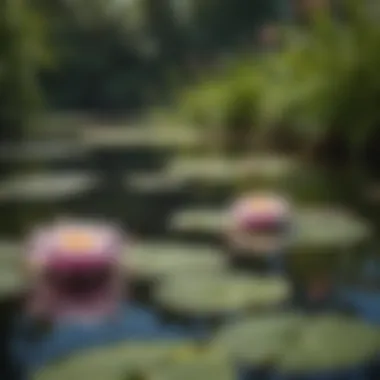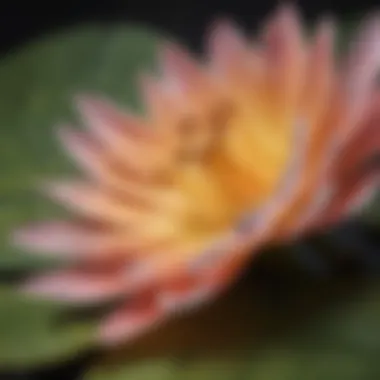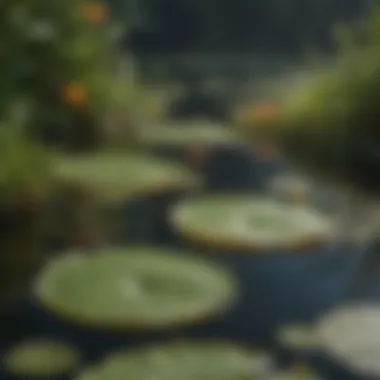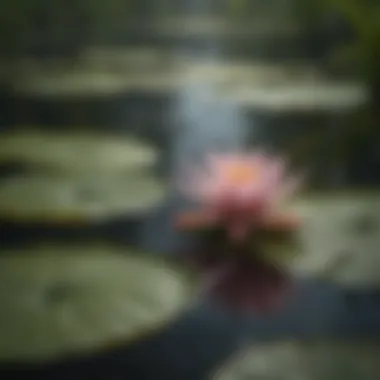The Intricacies of Flowering Lily Pads: A Comprehensive Exploration


Intro
Flowering lily pads are not just beautiful elements in aquatic landscapes; they hold ecological importance that warrants a deeper understanding. These plants belong to the family Nymphaeaceae and are essential players in freshwater ecosystems. This article aims to provide a meticulous examination of flowering lily pads, weaving together their biological characteristics, ecological roles, cultural implications, and the conservation challenges they face.
Understanding flowering lily pads involves exploring their unique traits and behaviors, uncovering new scientific revelations, and recognizing their significance in folklore and art. Conservation efforts are paramount as these plants require attention and protection.
Fascinating Facts About the Plant
Unique Characteristics
Flowering lily pads possess several distinctive traits that make them remarkable. Their broad, flat leaves float on the water's surface while their flowers, which bloom in various colors, create an enchanting visual spectacle.
These plants are adapted to a variety of water conditions, thriving in both still and slow-moving freshwater environments. The leaves can vary in size from a few inches to almost four feet in diameter, depending on the species. The various colors of their flowers range from white to pink, yellow, and blue.
Extraordinary Abilities
One of the most interesting abilities of flowering lily pads is their capacity for photosynthesis, a process vital for their growth and energy production. This ability not only sustains the plant but also contributes significantly to the aquatic ecosystem by providing oxygen.
Additionally, lily pads play a crucial role in providing habitat for various aquatic organisms. The large leaves act as shade for fish and invertebrates, while the flowers attract pollinators such as bees and butterflies.
Ecological Importance
Flowering lily pads contribute to the health of freshwater systems in diverse ways. They help stabilize sediments, thus preventing erosion. Furthermore, their presence can enhance water quality by filtering pollutants and providing oxygenation to the water, which is essential for other aquatic life forms.
Moreover, they support a unique microhabitat that supports a range of wildlife, from microbes to larger animals. The interdependent relationships formed within these habitats illustrate the complexity of aquatic ecosystems.
Recent Scientific Discoveries
Latest Research Findings
Recent studies have unveiled fascinating insights into the reproductive strategies of flowering lily pads. These investigations have shed light on their specific pollination mechanisms and the genetic diversity within species.
Breakthroughs in Plant Biology
Scientific advancements have also facilitated the understanding of how flowering lily pads respond to environmental changes. Studies indicate that these plants exhibit remarkable resilience, adapting to conditions such as varying water levels and temperature fluctuations. Such knowledge can inform conservation strategies aimed at ensuring their survival in the face of habitat alteration.
Cultural Significance
Plants in Folklore
Flowering lily pads have a prominent place in various cultures and mythologies. Often symbolizing purity and beauty, they appear in literature and stories across numerous civilizations, with their blooming often viewed as a sign of enlightenment and rebirth.
Influence on Art and Literature
The aesthetic appeal of flowering lily pads has inspired countless artists, from Claude Monet to contemporary creatives. Their visual beauty has allowed artists to convey deeper themes of nature and tranquility. Their imagery also frequently appears in poetry and prose, further establishing their cultural relevance.
"The beauty of the lily pads captivates the mind and nourishes the soul, reminding us of nature's delicate balance."
Prologue to Flowering Lily Pads
Flowering lily pads are not just a beautiful feature of many ponds and lakes; they play a crucial role in the health and stability of aquatic ecosystems. This section lays the foundation for understanding why these plants warrant deeper exploration. Their unique attributes and the roles they serve in nature reflect broader ecological principles that impact biodiversity, water quality, and aquatic habitats.
Defining Flowering Lily Pads
Flowering lily pads belong to the family Nymphaeaceae, consisting primarily of the genera Nymphaea and Nuphar. They thrive on still or slow-moving waters, where they float gracefully on the surface. The plants produce large, flat leaves, which are often round and circular, providing a distinct silhouette against open water. These pads serve as a platform for the plant's beautiful flowers, which range in color from white to pink, and even yellow, depending on the species.
These pads accumulate nutrients, assist in oxygenation, and support the unique reproduction mechanisms of the lily pads, which include both sexual and asexual processes. Understanding the definition of flowering lily pads includes recognizing their biological and ecological identities.
Importance in Aquatic Ecosystems


Flowering lily pads have significant importance in aquatic ecosystems. Their presence contributes to several ecological benefits:
- Habitat Creation: They provide shelter and breeding grounds for various aquatic creatures, including fish, amphibians, and insects.
- Nutrient Cycling: Lily pads play a crucial role in nutrient cycling within a habitat. Their decomposition process contributes organic matter to the water, enriching the aquatic environment.
- Water Quality: The leaves and stems of lily pads help filter pollutants and absorb excess nutrients, which can improve water quality.
- Shade and Temperature Regulation: The canopy created by lily pads regulates water temperatures, offering a cooler environment for the aquatic creatures below.
- Biodiversity Support: By fostering a diverse range of species, these plants help maintain the ecological balance essential for a thriving ecosystem.
This illustrates the multifaceted role that flowering lily pads play within their ecosystems, underscoring the need for their protection and conservation.
Botanical Characteristics
Understanding the botanical characteristics of flowering lily pads is vital to appreciate their role in aquatic environments. These characteristics help to explain how these plants function, adapt, and contribute to their ecosystems. Moreover, knowledge of their anatomy, growth patterns, and reproductive strategies fosters a deeper awareness of their ecological roles.
Anatomy of Lily Pads
Lily pads, or leaves of the freshwater plant Nymphaea, display a unique structure that adapts them for life on the water’s surface. The leaves are broad and flat, creating a large surface area. This characteristic allows them to effectively capture sunlight, essential for photosynthesis. The leaf structure includes a waxy coating that minimizes water loss and a system of veins for nutrient transport.
This anatomical design supports resilience against water movements. The petiole, or stem, is flexible, allowing the leaves to float even in turbulent waters. Understanding the anatomy of lily pads reveals how these plants have evolved to thrive in aquatic habitats. A detailed view of the leaf adaptation showcases their role in maintaining ecological balance.
Growth Patterns
Lily pads exhibit specific growth patterns influenced by environmental factors like light availability and water temperature. In optimal conditions, these plants can spread rapidly, forming dense colonies on the water’s surface. They primarily grow in shallow waters, where roots can anchor to the sediment while their leaves float above.
Seasonal variations also affect growth rates. During warmer months, the growth accelerates, potentially leading to expansive mats that provide shelter for aquatic organisms. This trend can significantly affect local biodiversity, creating habitats for fish, amphibians, and insects. Monitoring growth patterns is essential for understanding the ecological dynamics in aquatic systems.
Lifespan and Reproduction
The lifespan of flowering lily pads varies based on environmental conditions. Generally, these plants can live for several years under suitable circumstances. Their ability to reproduce plays a crucial role in sustaining populations. Lily pads primarily reproduce through vegetative means. Offspring can arise from runners or tubers, enabling the plant to expand its reach and colonize new areas.
Moreover, flowering is an essential reproductive strategy. The flowers emerge above the water surface, attracting pollinators such as bees and beetles. This mechanism not only promotes genetic diversity but also supports the surrounding ecosystem by providing food for various species. Understanding the lifecycle and reproductive strategies of lily pads is crucial in assessing their environmental impact and resilience against threats.
The intricate life cycle of flowering lily pads highlights their adaptive strategies, which are essential for thriving in diverse aquatic ecosystems.
Ecological Roles and Benefits
Flowering lily pads are far more than mere decorative elements on water surfaces; they play crucial roles in their ecosystems. Their presence enhances biodiversity, stabilizes structures, and promotes healthier water conditions. In this section, we will discuss the specific ecological roles and benefits provided by flowering lily pads.
Habitat for Aquatic Wildlife
Flowering lily pads create unique habitats for various forms of aquatic life. These plants provide shelter and breeding grounds for fish, amphibians, and invertebrates. The leaves of lily pads offer resting places for small creatures, while the spaces beneath the surface serve as breeding sites for many species.
For example, young fish often find refuge from predators in the shade of lily pads. The complex structure of the plants increases habitat diversity, allowing various species to thrive. Additionally, lily pads can attract pollinators like bees and butterflies, contributing to a healthy ecosystem overall.
- Key species that benefit from lily pads include:
- Bluegill sunfish
- Dragonflies
- Frogs
Water Quality Improvement
Flowering lily pads also improve water quality in several ways. They can filter pollutants, absorb excess nutrients, and thus reduce problems like algal blooms. By actively removing toxins and providing shade, lily pads help maintain a balanced aquatic environment.
Moreover, they play a role in moderating temperature fluctuations in the water. The shaded areas created by these plants help keep the water cool. Cooler water temperatures can increase oxygen levels, which is critical for the survival of aquatic organisms.
The benefits of water quality improvement are substantial:
- Reduction of harmful algal blooms.
- Decrease in sedimentation rates.
- Enhanced water clarity and purity.
Carbon Sequestration
Lily pads contribute to carbon sequestration, a process vital for combating climate change. By capturing carbon dioxide during photosynthesis, they play a role in reducing atmospheric CO2 levels. The biomass of lily pads can store significant amounts of carbon, making them an integral part of the carbon cycle in aquatic environments.
Therefore, the conservation of flowering lily pads not only serves ecological benefits but also addresses global environmental issues. Their ability to sequester carbon supports broader conservation efforts aimed at sustainable ecosystem management and reduction of climate impact.
Lily pads are essential to aquatic life and human environmental considerations, providing both direct benefits and contributing to global ecological stability.


Flowering Processes
Understanding the flowering processes of lily pads is essential for grasping their role in ecosystems and their importance in biodiversity. Flowering is not merely a reproductive method; it serves various ecological functions and contributes to the overall health of aquatic environments.
Pollination Mechanics
Pollination mechanisms in flowering lily pads showcase a sophisticated interplay between plants and pollinators. Most species rely on insects, such as bees and beetles, to transfer pollen. The intricate adaptations of petals in these plants attract specific pollinators, ensuring efficient reproduction.
Key Elements of Pollination:
- Structure of Flowers: The shape and color of lily pad flowers are designed to attract relevant pollinators. Some flowers open during the day while others bloom at night, catering to diurnal and nocturnal pollinators.
- Pollen Availability: Different species can produce varying amounts of pollen, which can influence the visitation rates of pollinators. More abundant pollen may lead to more frequent visits and effective fertilization.
- Timing of Flowering: Timely flowering can dictate the success of pollination. If lily pads flower when pollinators are active, they maximize the chances of reproduction.
Pollination plays a crucial role in maintaining genetic diversity within populations. A diverse gene pool enhances resilience against diseases and changes in environmental conditions, aiding long-term survival.
The importance of pollination cannot be overstated; it is pivotal in ensuring the continuation of species and maintaining the balance of aquatic ecosystems.
Variability in Flowering Times
The variability in flowering times among different species of lily pads adds another layer of complexity to their ecological roles. This adaptation can be influenced by several factors, including environmental conditions and genetic traits.
Factors Influencing Flowering Variability:
- Temperature and Climate: Changes in temperature can trigger earlier or later flowering. Warmer temperatures may cause some species to flower earlier, while cooler conditions can delay blooming.
- Water Levels: Fluctuations in water levels can also play a significant role. Some lily pads may not flower if submerged for extended periods, while others may adapt by adjusting their blooming schedule.
- Nutrient Availability: Availability of nutrients in the water can influence the growth and flowering of lily pads. When nutrients are plentiful, plants might flower more prolifically.
Understanding the timing of flowering is essential for conservation efforts. It can dictate the best times for restoration initiatives. It also impacts pollinator behaviors and interactions, which are crucial for sustaining the life cycles of these beautiful aquatic plants.
Cultural Significance
Flowering lily pads hold a notable place in various cultures around the world. Their unique beauty and serene presence in water bodies contribute to rich symbolism and artistic expressions. Understanding the cultural significance of these aquatic plants helps highlight their role beyond mere decoration in gardens and ponds.
Symbolism in Various Cultures
The symbolism of flowering lily pads varies widely across different cultures. In many traditions, they represent purity and tranquility. This stems from their ability to emerge from muddy waters and bloom beautifully. In Asian cultures, the lotus flower, closely related to lily pads, is a powerful symbol of spiritual enlightenment and rebirth.
- In ancient Egyptian culture, the blue lotus flower is associated with the sun and creation, reflecting regeneration and the cyclical nature of life.
- In Buddhism, the lotus symbolizes purity of the body, speech, and mind, representing the journey towards enlightenment amidst the challenges of life.
- In Hindu traditions, it is often a seat of the gods, showcasing divine beauty and the idea of spiritual awakening.
This rich tapestry of meaning demonstrates how flowering lily pads connect deeply with human experiences and beliefs.
Use in Art and Literature
Flowering lily pads have made significant appearances in art and literature. Artists have captured their elegance, making them subjects in various forms of expression.
- Monet's Water Lilies: The famous works by Claude Monet exemplify this. His series of paintings captured the ethereal beauty of his garden’s lily pond, showcasing the play of light and color. This not only demonstrated his artistic brilliance but also made flowering lily pads icons of Impressionism.
- Literary References: In literature, they often symbolize tranquility and isolation. Authors use their imagery to evoke thoughts of peace or reflect the inner states of characters. Their presence in poetry often highlights themes of impermanence and beauty.
This incorporation in diverse artistic realms enriches our understanding of flowering lily pads. They are more than aquatic plants; they embody human emotion and artistry.
Conservation Challenges
Conservation challenges regarding flowering lily pads highlight the various threats these unique aquatic ecosystems face. Understanding these challenges is vital, as they provide insight into the pressing issues impacting both lily pads and the larger aquatic environment. Effective conservation measures will require collaborative efforts and informed strategies that consider the very specific elements that threaten these lily pads and their habitats.
Threats to Habitats
The habitats of flowering lily pads are increasingly under threat from several factors. Urban development is one such element. As cities expand, wetlands and ponds often disappear, leading to a decline in suitable environments for these plants.
Another issue is pollution. Chemicals from agricultural runoff and industrial waste can alter the water quality of lakes and ponds, harming the growth and reproduction of lily pads. The introduction of nutrients like nitrogen and phosphorus can lead to algal blooms, which suffocate aquatic plants and disrupt ecosystems.
Additionally, climate change poses a significant risk. Temperature changes and altering precipitation patterns may shift the water levels in habitats. This can disrupt the delicate balance necessary for the survival of flowering lily pads, ultimately reducing their populations.
Invasive Species Issues


Invasive species present a substantial risk to native flower lily pad populations. Species such as the water hyacinth, which thrives in nutrient-rich waters, can spread rapidly and compete for resources. This competition is often detrimental. It can smother lily pad growth and reduce their access to sunlight and nutrients necessary for survival.
Furthermore, invasive fish species may predate on lily pad seeds or seedlings. These fish can disrupt local food webs, leading to further declines in native flora. Controlling invasive species is complicated and may require extensive management efforts, which are often resource-intensive and require community involvement to be effective.
Human Impact on Ecosystems
Human activities significantly influence the health of aquatic ecosystems where flowering lily pads thrive. Development projects, such as the construction of roads or buildings near waterways, can lead to habitat destruction, fragmentation, and increased run-off into water bodies.
Recreational activities, like boating and fishing, also have an impact. These activities can physically damage lily pads and disturb their natural habitats. Moreover, pollution resulting from littering and waste disposal directly affects the water quality that flowering lily pads depend on.
Addressing human impact is essential. It requires education and awareness combining stakeholders from communities, governmental bodies, and environmental organizations.
Overall, conservation efforts must be grounded in a deep understanding of these challenges. By recognizing the specific threats to flowering lily pads, effective actions can be taken to preserve these valuable plants and their ecosystems.
Conservation Efforts
Conservation of flowering lily pads is critical for sustaining biodiversity and fostering healthy aquatic ecosystems. These plants offer essential functions, like serving as habitats and enhancing water quality. However, their survival is increasingly threatened by human activities and environmental changes. Addressing these concerns necessitates dedicated conservation efforts at various levels.
Current Conservation Initiatives
Several organizations and governmental bodies have launched initiatives focused on the preservation of flowering lily pads. These include:
- Habitat Restoration Programs: These aim to restore damaged aquatic environments. Techniques include planting native lily pad species and removing invasive plants to help restore balance.
- Research Projects: Academic institutions often conduct studies to understand the biology of lily pads better. This helps identify effective conservation techniques and monitor lily pad health.
- Legislation and Policies: Governments formulate legislation to protect waterways from pollution and overdevelopment. Such measures directly impact the survival of lily pads by safeguarding their habitats.
- Public Awareness Campaigns: Non-profits and community groups often engage in outreach efforts to educate the public on the importance of lily pads. These programs seek to increase community involvement in conservation activities.
Effective conservation requires a collaborative effort among governments, researchers, and the community.
Community Involvement and Education
Community involvement plays a significant role in conservation efforts for flowering lily pads. Engaging local populations through educational programs fosters a sense of ownership and responsibility toward their natural environments. Examples of effective community-focused initiatives include:
- Workshops and Seminars: These events provide knowledge about the ecological benefits of lily pads and encourage responsible practices to protect them.
- Volunteer Opportunities: Local conservation groups frequently organize river clean-up days or planting events where community members can participate actively. Such engagement reinforces their connection to local ecosystems.
- Youth Programs: Educating children about flowering lily pads can inspire future generations to value and protect aquatic ecosystems. Schools often partner with environmental organizations to incorporate hands-on learning experiences.
Future Research Directions
Future research into flowering lily pads is crucial for understanding their roles within aquatic ecosystems and addressing the challenges they face. As global environmental changes continue to reshape ecosystems, it becomes necessary to explore innovative practices in botany and technology. Such research not only enhances scientific knowledge but also enables the development of effective conservation strategies.
Innovations in Aquatic Botany
Innovative research in aquatic botany can lead to significant discoveries relating to flowering lily pads. One promising area is the enhancement of hybridization techniques for breeding. By creating hybrids, scientists can develop plants that are better suited to cope with changing water conditions. This can improve resilience against climate variations.
Another innovation involves soil health assessment. Understanding the soil chemistry can lead to improved growth patterns for lily pads. If the nutrient levels in their environment are better monitored, it may result in healthier populations. This could potentially increase their contribution to carbon sequestration, further emphasizing their importance in mitigating climate change.
Key Considerations
- Genetic Research: Understanding the genetic makeup can aid in developing strains that resist diseases.
- Sustainability Practices: Exploring sustainable gardening practices ensures that lily pads thrive in human-created ponds and habitats without negative consequences.
Integrating Technology for Monitoring
Advancements in technology have the potential to revolutionize the way flowering lily pads are monitored. Utilizing remote sensing technology allows scientists to gather data on large bodies of water without disrupting the ecosystem. This data is vital in understanding the health and distribution of lily pads across various environments.
Moreover, employing drones enhances monitoring capabilities. Drones can be used to assess the growth patterns and spatial distribution of lily pads from above. This ability provides a broader perspective that traditional methods cannot match.
Benefits of Technological Integration
- Real-time Data Collection: Instantaneous data can lead to quicker responses to environmental changes.
- Community Engagement: Technology can also promote public involvement in scientific studies, leading to greater awareness about the significance of lily pads.
Ending
Summary of Key Points
The exploration of flowering lily pads reveals several significant aspects. First, these plants play a vital role in aquatic ecosystems, serving as a habitat for numerous species and improving water quality. Second, their unique structures and growth patterns demonstrate an incredible adaptability to their environments. The flowering processes discussed include fascinating pollination mechanics that vary across different species. Cultural significance is another element that adds layers to our understanding, as examples can be found in various cultures around the world. Lastly, conservation challenges highlight the ongoing threats these plants face due to human impact, invasive species, and habitat destruction, necessitating effective initiatives for protection.
Call for Action in Conservation
In light of the discussed issues, there is an urgent need for concerted conservation efforts targeted at protecting flowering lily pads. These plants do not benefit only the ecosystem but also human communities that rely on clean water and biodiversity. Engaging in local cleanup efforts, advocating for sustainable practices, and supporting organizations focused on habitat restoration are essential steps.
It is imperative to recognize that our collective actions can have profound impacts. We all play a part in preserving the delicate balance of aquatic ecosystems, and every initiative counts. Raising awareness and education on the importance of these natural habitats can galvanize community action, leading to sustainable practices that ensure the survival of flowering lily pads for future generations.







